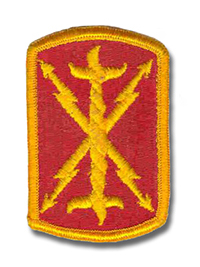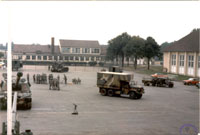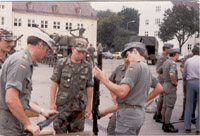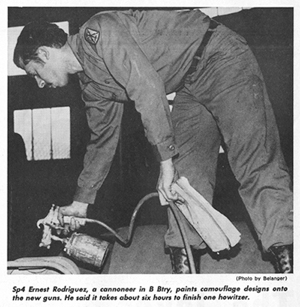| If you do
NOT see the Table of Contents frame to the left of this page, then Click here to open 'USArmyGermany' frameset |
||||||||||||||||||
17th Field Artillery Brigade |
||||||||||||||||||
|
|
||||||||||||||||||
|
||||||||||||||||||
|
|
||||||||||||||||||
| 17th FA Brigade History | ||||||||||||||||||
| 1978 | ||||||||||||||||||
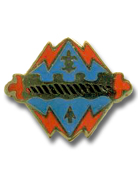 17th Field Artillery
Brigade DUI
17th Field Artillery
Brigade DUI |
||||||||||||||||||
| (Source: Field Artillery Journal, Sept-Oct 1978) | ||||||||||||||||||
| The 17th Field Artillery Group was activated in Augsburg, Germany on 22 Aug 1978. Subordinate units of this headquarters will be the following: |
||||||||||||||||||
|
||||||||||||||||||
| Commanding the reorganized unit (formerly the 46th Artillery Brigade) is COL Donald L. Burton. | ||||||||||||||||||
1983
|
||||||||||||||||||
| (Source: 17th FA Brigade Change of Command, 11 January 1983 - Webmaster's collection) | ||||||||||||||||||
Headquarters and Headquarters Battery, 17th Field Artillery Brigade was redesignated as HHB, VII Corps Artillery on 13 March 1944 and served in Europe during the latter stages of WWII. The unit was inactivated on 15 November 1945 at Fort Ord, Cal. HHB, VII Corps Artillery was reactivated on 22 Jan 1951 at Fort Campbell, KY. The unit subsequently moved to Germany with VII Corps and served in FRG until being inactivated on 21 June 1975. The unit was redesignated as Headquarters and Headquarters Battery, 17th FA Brigade on 2 Aug 1978 and activated in Augbsurg, Germany. Col Andrew J. McVeigh III was commander of the 17th FA Bde from 2 June 1980 until 11 Jan 1983. Following Col McVeigh as Bde CO was Col. Robert B. Adair. SUBORDINATE BATTALIONS : - 1st Battalion 18th FA CO: LTC Edward G. Anderson III; Cmd Sgt Maj: CSM Ronald J. Jarmusek On 1 Oct 1976, the Battalion (155mm SP) deployed from CONUS to Augsburg, Germany and was assigned to VII Corps, 210th Artillery Group. On 22 Aug 1978, the Battalion was reassigned to the newly activated 17th FA Bde. - 1st Battalion, 30th FA CO: LTC Dennis D. McSweeney; Cmd Sgt Maj: CSM John H. Culp The 30th FA Battalion was activated on 22 Feb 1949, and assigned to EUCOM and attached to the 1st Inf Div in Germany. The Battalion was stationed at Erlangen until Feb 1957 (when it probably returned to the US as part of Operation GYROSCOPE.). (The unit was redesignated as 1st Howizter Battalion (155mm), 30th FA on 25 June 1958.) On 12 Oct 1976, the Battalion arrived in the FRG as a unit in support of the Increased Combat Capability Europe (ICCE) effort, and was assigned to the 210th FA Group, VII Corps Artillery, with a mission to support NATO forces in Europe. On 22 Aug 1978, the Battalion was reassigned to the newly activated 17th FA Bde. - 1st Battalion, 36th FA In the Spring of 1957, the 36th FA Battalion was designated a GYROSCOPE unit and prepared to depart for Germany. The Battalion arrived in Europe and was assigned to Seventh Army on 13 Feb 1958, with its home station at Schwäbisch Hall. On 1 Aug 1963, the 1st Bn, 36th FA and 1st Bn, 83rd FA exchanged colors and home stations, which resulted in 1st/36th FA being stationed at Ferris Barracks, Erlangen. On 7 July 1966, the Battalion moved to Wiley Barracks in Neu Ulm and remained there until 12 Aug 1968. At that time it moved to Reese Barracks in Augsburg, and was later assigned to the 17th FA Brigade. - 2nd Battalion, 42nd FA 2nd Bn, 42nd FA was activated on 1 Oct 1973 as a LANCE missile unit at McKee Barracks, Crailsheim, Germany and was later assigned to the 17th FA Bde.. |
||||||||||||||||||
| If you have more
information on the history or organization of the 17th FA Bde (or
any of the subordinate units), please contact me |
||||||||||||||||||
| (Source: Email from Mike Rogers, HHB, 17th FA Bde) | ||||||||||||||||||
| The 1/18 FA in 1982-83 was at Sheridan Kasserne in Augsburg. I don`t remember the name of the Barracks, but HHB Barracks were right next door to an NCO Academy. We had the Honor of unloading and carrying ALL the furniture up those stairs to the rooms before it opened. I also recall the Movie Theater on the way to the Mess Hall being right there. Service Battery was in our Barracks but the Firing Batteries were down by the Motor Pool. Also an MP unit next to us with Medics. Here are a couple pics from an 'Open House' when some German Comrads came to visit. One from HQ the other in the parking lot facing HQ. Amazing how clear the memories are after 23 years. |
||||||||||||||||||
|
||||||||||||||||||
|
|
||||||||||||||||||
1990
|
||||||||||||||||||
| (Source: Email from Scott Grev, HQ 17th FA Bde, 1990-93) | ||||||||||||||||||
I was assigned to the 17th FA Bde headquarters in Augsburg from January 1990 to September 1993 as the Bde Intelligence Officer. The brigade commander was Col. William Ott. Only a couple of months after I was assigned (late spring as I recall) we were notified that we would inactivate the four subordinate battalions, but I can't remember if we thought at the time that we would inactivate the brigade HQ. We began preparing equipment for transfer to POMCUS sites or to other units, and soldiers and their families began shipping out in the summer and fall of 1990.
Shortly after Iraq invaded Kuwait any further transfers of people and equipment were put on hold. The "freeze" was ordered so that the remaining troops and/or equipment could be available, or the brigade could possibly be reconstituted if necessary for compat operations.
When VII Corps was notified of deployment to the Gulf, 17th FA Brigade had already transferred too much equipment and personnel to be rated as combat-ready. Myself and several others were attached to VII Corps Artillery HQ or other corps artillery brigades. I was the Deputy Intelligence Officer/Targeting Officer for VII Corps Arty during Desert Shield and Desert Storm and worked for Maj. Dan Pass (G2) and BG Creighton Abrams Jr. At the conclusion of the conflict, several of the attached 17th Bde officers were tasked to run the redeployment seaports in Dhahran and Al Jubayl. I believe that most of the 17th Bde personnel returned to Germany in late May/early June of 1991 when our mission at the seaports concluded. We were notified that the brigade HQ would be transferred to Ft. Sill, OK, while we were still in the Gulf. Sometime in between December 1990 and May 1991 Col. Alan Fox assumed command of 17th FA Bde. The brigade resumed the inactivation of the four battalions after the cease-fire in the spring of 1991. The four battalions were inactivated by winter 1991, and we held a terrific farewell ceremony and dedication of an "Artillery Park" in the snow on Sheridan Kaserne in late November or early December. The brigade "cadre" were locked-in to the redeployment to Ft. Sill, where we reconstituted with four new battalions.
|
||||||||||||||||||
| 1st Bn, 18th FA (155mm SP) | ||||||||||||||||||
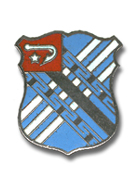 1st Bn, 18th FA DI (Dec 1982 issue) 1st Bn, 18th FA DI (Dec 1982 issue) |
||||||||||||||||||
| 1976 | ||||||||||||||||||
| (Source: Email from George Stotz, 1976-79) | ||||||||||||||||||
| I was assigned to the 1/18th FA at Fort Sill and was a member of the advanced party that took the battalion to Augsburg in the Fall of 1976 and remained with them until the Fall of 1979. Then Major Ellis was the commander of the advanced party. We used to call him “Flash”, because he was in continual motion. Our battalion commander was LTC Bob Adair, who passed away several years ago -- a real leader, gentleman and one outstanding commander. This assignment was one of my more memorable assignments with a great group of professionals. We had a top notch battalion, and overcame tremendous challenges along the way. |
||||||||||||||||||
| 1985 | ||||||||||||||||||
| (Source: Email from Robby Height, Feb 1985 - April 1987) | ||||||||||||||||||
| My first duty assignment was with SVC BTRY 1/18 FA as a brand new private out of Fort Sill. Augsburg and Sheridan Kaserne was a great place to start my artillery career. I arrived Feb 1985 and departed in April 1987. Those of us that served during that time remember Kalkas outside the gate and the Last Chance bar. We were a 155sp BN with the M109A3’s. Being an ammo dog, we humped round after round on our many rotations to Graf. The 17th FA BDE CDR during that time was COL Ronan I Ellis, we use to call him Ronan The Barbarian. He was famous for his starched coveralls and loved to crawl in engine wells during the BDE Inspections. I arrived on a snowy Sunday morning into Frankfurt and road a bus to BDE HQ’s on Reese Kaserne arriving around 0100, cold and no idea what I was doing. I remember the SDNCO gave us a blanket (3 of us) and made us sleep in the dayroom until we got our TA 50 and rotated and caught the shuttle (the VW vans from the TMP) and sent to Graff. Welcome to Germany. SVC Battery was a special group of guys who took pride in all they did. The battalion was configured as a 3 X 6 direct support. I was young back then and not sure who we supported. Our battery consisted of Ammo sections, HQ's, Mechs, Fuel boys and commo. The ammo sections (4 or 6, not sure it's been many years) were equipped with the M813 5-ton trucks configured for cargo carrying with 6 bows and cargo canvass covering. Each truck, 5 per section, was assigned a driver who was responsible for the maintenance and appearance of the vehicle. Although it was a tactical vehicle, we took pride in our trucks. I remember our Btry Commander encouraged each of us to install stereos with speakers, remove the bench seating and install bucket seats from the 915 semi trucks, new mirrors etc. We were a mini long haul trucking outfit, a mix of 13B's and back then 64C (now 88M's motor transport specialists). Service battery was the advanced party for the HOW battery's. The Ammo Dogs would convoy to Graf a week prior to the HOW btry's deployment, establish the ammo collection point (ACP), and prepare for drawing of all ammunition required for a 45 day rotation. We lived on Ammo pads out in the middle of Graf. A warm shower back then was sometimes 10 to 14 days up to 20 days away. Upon arrival to the ACP, we would spend hours setting up the site: GP Mediums 4 ea. 2 sections per and one for a mess hall, GP Small for the TOC and 1 for Smoke and the LT. Of course all had to have Pot Belly stove (2 per Medium). Each member Soldier had cots with A and B bags with all there gear. Everything was dress right dress inside regardless of the 24 hour ops we ran in support of the BN's mission. Our camp was impressive and we had it down to a science, but mind you, it wasn't on concrete like the HOW btry, we lived on dirt and rocks. Once our AA was established we prepared to draw ammunition. Each vehicle had to be stripped of all slats, covers etc, and then had to be pre-inspected from top to bottom to ensure that they met the inspection criteria at the ASP. Issue date was stressful for all. Each vehicle was configured to pick up a specific type and amount of ammunition, be it HE, illumination, Smoke, WP, powder, fuses, or 5.56mm, 7.62 and .50 cal for the ranges. If your vehicle failed inspection, the Germans would not allow you into the ASP therefore not able to pick up your assigned cargo. God help you if your vehicle failed. It could be for anything from improper seal on your fire extinguisher to a class II leak on the tranny. Sometimes pickup would take us 14 to 18 hours. Everything was accounted for and loaded onto the trucks by forklifts. We secured the cargo, and moved out to the front gate. Once all BN's draw was accounted for and vehicles lined up in convoy config, we went tactical from this point on for the long drive back to the "pad". Upon arrival, ammunition could not be stored or left on the vehicles. Everything had to be downloaded onto pallets in predetermined areas and covered. We didn't have forklifts, this is when the esprit de corps and Ammo Dog spirit took over. A 155mm HE weighs 96.2 lbs. They had to be lifted off the truck, onto your shoulder and carried over and placed onto a ammo pallet. I believe there were 30 of us, and I can remember doing downloads of 600 to 700 rounds to include all powder, fuses and additional ammunition. This is where the term "Humping" came from. This was the BN's ASP. Our missions were continuous, we had no break for a 45 day Graf rotation. When the HOW Btry's were out, we were on call. I remember 0200 hrs setting up an emergency resupply (now called a FARP). Those beautiful howitzers with the 557's would come off that tank trail, we would assume responsibility at the entrance, of course night tactical, guide them into their predesignated area, and get them in and out. Beautiful Chaos. Once they did there "hot upload" into the fuel lines, and gone. Then we packed up the residue and went back to the pad, pulled guard, ate a little and got ready for the next one. That was the life of an Ammo Dog. We were always dirty, wet, cold miserable but we took pride in what we did. I can't ever remember missing an issue time or place. The Howitzers of the 1/18th never went without ammunition. In addition to the many rotations to Graf, the 1/18th also took part in the REFORGER exercises. Our GDP was a place up on the boarder called Voinsehag (sp) pronounce "VO In SEE HAG." We set up our tactical sites in farmers barns and pulled radio watch in a small gasthaus. Service Btry would return twice a year to recon the area, etc. This was explained to be our area if Russia ever came. Cold War tactics. The town welcomed us each time we would arrive. A great place and a great community. I remember one time pulling guard overlooking a beautiful farm. A small girl came up with a bag full of broatchens with cheese and some bottles of soda. I gave her my soft cap (wasn't supposed to have it) and she ran away smiling. Me and my battle buddy sat there and ate so good that night. SVC Btry was all in support of the BN's Nuclear mission. We had a designated truck for pickup and delivery that carried nothing but the simulator and stood by on call. Those of us involved with the program were all cleared and placed on the PRP. We rehearsed with the special weapons section on a weekly basis. We all wanted to get back to the "World" but damned if we didn't love the 1/18th, especially service battery. I'm sorry that I've rambled on, but haven't thought about that unit in years. A buddy of mine (Fred Budd) reached out to me this week through facebook and brought back some incredible memories, this is how I found your site. Thank you for keeping it together. Please let me know if I can provide anything else. Theres more stories about the unit like the fielding of the HEMTT (first in USAREUR) and the death of the Alpha Btry commander and his driver. WOW it just all comes rushing back. |
||||||||||||||||||
| 1st Bn, 30th FA (203mm SP) | ||||||||||||||||||
| 1981 | ||||||||||||||||||
| (Source: AUGSBURG SCENE, December 10, 1981) | ||||||||||||||||||
| Battalion readies new guns for debut 1st Battalion, 30th Field Artillery received 12 new M110A2 howitzers to replace all of their guns with the new model. "The howitzer change indicates to me the continued effort on the part of the Army to upgrade the equipment in the NATO," said Lt. Col. Dennis McSweeney, Battalion Commander. Although the appearance of the new guns is identical with the former model, several modifications were made and this will make the cannoneer's job performance easier. The engine was modified to add more horsepower, a warning indicator light that used to be inside of the driver's cabin has been re-located to outside of the gun in a highly visible spot. The driver's seat can now be adjusted in height. This may not seem much of an improvement, but for the drivers who vary in size, this should help them a great deal. Alterations were made to the "Lock-out" system. The lock-out system is a stabilization platform when the gun is in firing position. "Accepting the new howitzers meant a great deal of maintenance assessments and supply actions for the sections," McSweeney said, "It started out with section chiefs performing a 100 percent inventory and maintenance checks on the old howitzers to bring them up to standard on the inventory check. The new guns also had to be inventoried." Last finishing touches are put on the new M110A2 howitzers at the 1/30th FA. Camouflage paint and winterization kits will get the new guns ready to be used in exercises."The guns are in for about 30 days. They are test driven and participated in alerts. The only thing they haven't done, was the actual firing," the commander said. Presently, some artistically inclined soldiers, armed with a paint gun in one hand and a color scheme in the other, apply camouflage paint to the new howitzers. The guns are delivered by the manufacturer painted in solid green. |
||||||||||||||||||
|
||||||||||||||||||
| 2nd Bn, 42nd FA (LANCE) | ||||||||||||||||||
| 72nd Field Artillery Bde | ||||||||||||||||||
| 1976 | ||||||||||||||||||
| (Source: Email from Sean Kivler, 2nd Bn, 42nd FA - 1976-1979 (72nd FA Gp); 1981-1984 (17th FA Bde) | ||||||||||||||||||
| I was browsing your site once again and wanted to make a couple of comments reference the 2/42 FA BN of formerly the 72d FA Group then later the 17th FA BDE.
I spent 2 tours of duty with this battalion as a FA surveyor. My first tour of duty was March 1976 thru January 1979; and the 2d was September 1981 thru August 1984. My initial tour was spent on the survey crew for A Btry as a surveyor/computer. At this time the bn was subordinate element of the 72d FA Group of Wertheim, FRG. My survey chief(s) were SSG Alexander, SSG Penrose and SFC Eustice Smith. I can't recall the Btry Cmdr's name but do recall he was a short black man who got his commission while in the Republic of Vietnam. I do remember he later got "RIFed" during the days of the "hollow army" and went back to his former enlisted MOS as a gun chief in an artillery unit; I believe he had orders for Ft Polk, LA. This first tour of duty was spent typically in the field. Our missions always seemed to take us to the GDP area if not the LTA near McKee Barracks. More often then not, we were doing GDP missions in the vicinity of the then Czech border. I can remember a lot of cold and miserable days without proper gear and only the friendliness of a the German people we met along our travels. Crailsheim, what little time I did get to spend there, was a pleasant place and enabled me to make a lot of friends. As this was my 2nd tour to Germany, I already could speak German conversationally and this opened a lot of doors that most GI's couldn't get through. Places like the "New Yorker" discoteque and the "Gasthaus Stern" bring back good memories of those times I could get into town. I eventually bought a used car and spent many weekends and evenings away travelling the countryside. Even this told me that I wasn't seeing the people so I started "trampen" wie wir sagen.... thumbing from McKee Barracks to over the border destinations. Actually I spoke pretty decent German and French. These two languages with my American English, got me a lot of friendships all over the West European continent. My 2d tour as I stated, was from Sept of 1981 thru Aug 1984. This time I brought my newly wed wife with me and was able to get "Quarters" in the housing area across the street from McKee Barracks. I was assigned to C Btry as a survey section chief under Chief of Survey SFC Meiggs, and my rater 1Lt Eide. The other survey section chief was SSG Richard Humphries. The Btry Cmdr was CPT Schwarnenburg, the Bn Cmdr was LTC Fredrick E Van Horn and the CSM was named Wilson then later replaced by CSM Farrow. I admired the Bn Cmdr immensly as he was Airborne Ranger qualified and he had an esprit de corps attitude I haven't seen since, but many times tried to emulate. I got many Certificates of Appreciation from him that ended up in my promo packets and ended up on my "fiche" that said "Nuke 'em"; where our bn logo would've normally read: "Festina Lente"... Make Haste Slowly". I loved the runs he took us on after bn calisthenics; through furrowed fields at 0:dark 30 and would last for at least an hour, if not 2. That LTC always made me want to grab the battalion guidon and run with him and around the running bn formation. As survey teams, we spent the majority of our time living in tents in the field. Villages with names like Marktredwitz, Tirschenreuth, Weiden, and Bernau bring back some educational memories. I still have the VHS I took while on the Hof Border Tour. It still opens the eyes of those who thought we were only there for fun and games... (REFORGER). Many good times were spent with my associates in survey at the Rod & Gun Club on the Kaserne. By the way, the 501st SPT Bn was that bn eluded to by Robert Eide who made comments on your site. |
||||||||||||||||||
| 17th Field Artillery Bde | ||||||||||||||||||
| 1980 | ||||||||||||||||||
| (Source: Email from Robert W. Eide) | ||||||||||||||||||
| I stumbled across this site pertaining to the 17th FA BDE, with your link as a contact for information. I was assigned to the 2/42 FA (Lance) on October 25 1980 as a 2LT assigned to Battery C. 1Lt Rick Harris was in command of Battery C, LTC Fred Van Horn was the battalion commander, Maj. John Westerlund was BN XO, Cpt Crary had A Btry, CPT Salzer had SVC Btry, CPT John Hughes had B Btry, and HHB was commanded by CPT (can't remember his name). I spent 18 months as a platoon leader and 18 months as BMO. LTC Van Horn had command for three years, into the middle of 1983. He initiated the Goetz Von Berlichingen ceremony for the officers and Sr. NCOs, sort of a battalion level St. Barbara event that was still going in 1986 when I visited the battalion during a REFORGER exercise. LTG Livsey became VII Corps commander during my time in Crailsheim and visited the battalion several times, including one memorable 'no notice walk in' to the motor pool when I was BMO. A few months later I escorted him to see the battalion during annual service practice (live fire) at NAMFI installation Crete. During LTC Van Horn's command he had several XO's including Maj Larry Taylor and one other between him and John Westerlund. I can't remember the middle one's name. I believe it was LTC Robert Wilson who succeeded Van Horn in battalion command. I last visited Crailsheim in 2002. McKee Barracks no longer exists. Only the trees remained and stacks of water pipes that were dug out of the ground. The housing area has been converted to civilian (3rd world national) housing and the DOD school is now a German grade school. I did find the widow of the German Maintenance Kaserne commander that adjoined the back of the McKee Barracks and she had fond memories of the early 80's when her husband commanded the German Kaserne. In fact, Werner made a point of finding me and meeting one time in Minnesota when he was visiting his daughter. Van Horn cultivated a close relationship with the local military and local police that paid off dividends during several incidents. I remain in contact with the daughter of the German colonel as she now lives in the States married to a former infantry officer. The 1/51 Inf Bn shared our Kaserne along with an ordnance company, a medical detachment, and a DS maintenance detachment. Those were great days and I have fond memories of my time there. |
||||||||||||||||||
| 1983 | ||||||||||||||||||
| (Source: Email from Dave Hein) | ||||||||||||||||||
| I happened across this site and noticed that there was a '?' after 2nd BN 42nd FA. Back in 1983-86 when I was stationed in Augsburg FRG, this battalion was part of the 17th FA BDE, VII Corps Artillery. 2nd Bn, 42nd FA was stationed at Crailsheim FRG, the other 3 battalions of the 17th FA BDE......1st Bn, 36th FA (8"SP), 1st Bn, 30th FA (8"SP), 1st Bn, 18th FA (155mm SP), were stationed in Augsburg. The 1-36th was stationed at Flak Kaserne and the 1-18th and 1-30th were stationed at Sheridan Kaserne. Hope you can use this info. I like your site. |
||||||||||||||||||
| (Source: Email from Joseph Porter) | ||||||||||||||||||
| Some of the information provided by Dave Hein is incorrect -- the 1/36th was NEVER at Flak Kaserne as Flak was where the Army hospital was. The 17th Brigade and the 1/36 were at Reese Kaserne until 1991 when they were rotated back the Ft.Sill and the 36th was deactivated. I served in the 1/36 from 1983 to 1985 in Augsburg at Reese. The following is an excerpt from Wiki: the 17th Brigade was called the 17th Field Artillery Brigade and did not become the 17th Fires Brigade until In 2007. The 17th Field Artillery Brigade moved to Fort Lewis, Washington and was renamed 17th Fires Brigade. The battalion was activated again on 18 January 1952 at Fort Sill, Oklahoma, as a towed 155mm gun battalion. In 1957 the battalion was designated a Gyroscope unit, and it transferred to Germany, arriving in Bremerhaven on 12 February 1958. On 25 June 1958 the 36th Field Artillery reorganized under the Combat Arms Regimental System, and the 36th Field Artillery Battalion became the new 1st Battalion, 36th Field Artillery, tracing its lineage from Battery A, 36th Field Artillery. On 1 August 1963 the battalion was reorganized as an 8 inch howitzer battalion. Since its arrival in Germany, it was stationed at Schwaebisch Hall, Erlangen, Neu Ulm, and Augsburg. In February 1987, it was one of the first nondivisional 8 inch battalions to be re-organized in the 24-gun, split battery configuration. It was one of the leading units in the Army developing tactics for this structure. |
||||||||||||||||||
|
|
||||||||||||||||||
| Related Links: |
||||||||||||||||||
